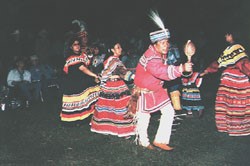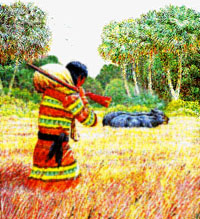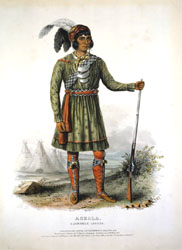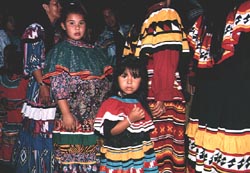Seminole History
The Seminoles of Florida call themselves the "Unconquered People," descendants of just 300 Indians who managed to elude capture by the U.S. army in the 19th century.
Today, more than 2,000 live on six reservations in the state - located in Hollywood, Big Cypress, Brighton, Immokalee, Ft. Pierce, and Tampa.
 The Seminoles work hard to be economically independent. To do this, they've jumped into a number of different industries. Tourism and bingo profits pay for infrastructure and schools on their reservations, while citrus groves and cattle have replaced early 20th-century trade in animal hides and crafts as the tribe's primary revenue sources.
The Seminoles work hard to be economically independent. To do this, they've jumped into a number of different industries. Tourism and bingo profits pay for infrastructure and schools on their reservations, while citrus groves and cattle have replaced early 20th-century trade in animal hides and crafts as the tribe's primary revenue sources.
While becoming more economically diverse, the Seminoles also maintain respect for the old ways. Some still live in open, palm-thatched dwellings called chickees, wear clothing that is an evolution of traditional styles, and some celebrate the passing of the seasons just as their ancestors did more than two centuries ago. They also visit schools and festivals across the state, performing traditional dance and music to share their history with non-Indians.
Creeks Migrate to Florida
Seminole history begins with bands of Creek Indians from Georgia and Alabama who migrated to Florida in the 1700s. Conflicts with Europeans and other tribes caused them to seek new lands to live in peace.
Groups of Lower Creeks moved to Florida to get away from the dominance of Upper Creeks. Some Creeks were searching for rich, new fields to plant corn, beans and other crops. For a while, Spain even encouraged these migrations to help provide a buffer between Florida and the British colonies.
The 1770s is when Florida Indians collectively became known as Seminole, a name meaning "wild people" or "runaway."
In addition to Creeks, Seminoles included Yuchis, Yamasses and a few aboriginal remnants. The population also increased with runaway slaves who found refuge among the Indians.
At war with the U.S.
 Run-ins with white settlers were becoming more regular by the turn of the century. Settlers wanted Indian land and their former slaves back.
Run-ins with white settlers were becoming more regular by the turn of the century. Settlers wanted Indian land and their former slaves back.
In 1817, these conflicts escalated into the first of three wars against the United States. Future U.S. President Andrew Jackson invaded then-Spanish Florida, attacked several key locations, and pushed the Seminoles farther south into Florida
After passage of the Indian Removal Act in 1830, the U.S. government attempted to relocate Seminoles to Oklahoma, causing yet another war -- the Second Seminole War.
After defeating the U.S. in early battles of the Second Seminole War, Seminole leader Osceola was captured by the United States in Oct. 20, 1837, when U.S. troops said they wanted a truce to talk peace.
By May 8, 1858, when the United States declared an end to conflicts in the third war with the Seminoles, more than 3,000 of them had been moved west of the Mississippi River. That left roughly 200 to 300 Seminoles remaining in Florida, hidden in the swamps.
For the next two decades, little was seen of Florida Seminole. At least not until trading posts opened in late 19th century at Fort Lauderdale, Chokoloskee and other places, that's when some Seminoles began venturing out to trade.
Seminoles gain more independence
In the late 1950s, a push among Indian tribes to organize themselves and draft their own charter began -- this came as a result of federal legislation which allowed Indian reservations to act as entities separate from the state governments in which they were located. After surviving the first half of the 20th century through agriculture and by selling crafts, individuals saw that organizing as a constitutional form of government would be a positive step. The Seminole tribe improved their independence by adopting a constitutional form of government. This allowed them to act more independently. So on July 21, 1957, tribal members voted in favor of a Seminole Constitution which established the federally recognized Seminole Tribe of Florida.
In 1970, the Indian Claims Commission award the Seminole (of both Oklahoma and Florida, collectively) $12,347,500 for the land taken from them by the U.S. military.

Thanks to Allen Morris' Florida Handbook and the Seminole Tribe of Florida. For More Information on Native People in Florida, Check Out: The official web page of the Seminole Tribe
